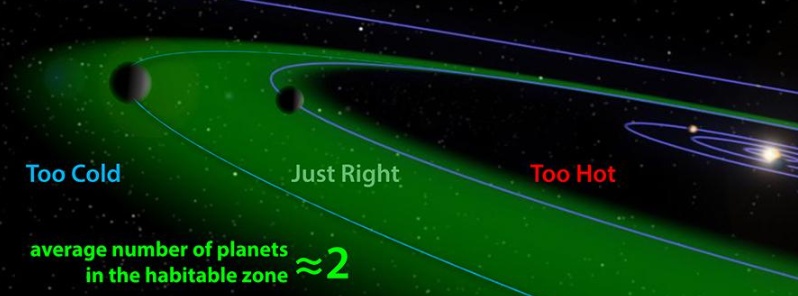Planetary scientists predict Earth-like planets around most stars

Planetary scientists have calculated that there are hundreds of billions of Earth-like planets in our galaxy which might support life.
The new research, led by PhD student Tim Bovaird and Associate Professor Charley Lineweaver from The Australian National University (ANU), made the finding by applying a 200 year old idea to the thousands of exo-planets discovered by the Kepler space telescope.
They found the standard star has about two planets in the so-called goldilocks zone, the distance from the star where liquid water, crucial for life, can exist.
“The ingredients for life are plentiful, and we now know that habitable environments are plentiful,” said Associate Professor Lineweaver, from the ANU Research School of Astronomy and Astrophysics and the Research School of Earth Sciences.
“However, the universe is not teeming with aliens with human-like intelligence that can build radio telescopes and space ships. Otherwise we would have seen or heard from them.
“It could be that there is some other bottleneck for the emergence of life that we haven’t worked out yet. Or intelligent civilisations evolve, but then self-destruct.”
The Kepler space telescope is biased towards seeing planets very close to their stars, that are too hot for liquid water, but the team extrapolated from Kepler’s results using the theory that was used to predict the existence of Uranus.
“We used the Titius-Bode relation and Kepler data to predict the positions of planets that Kepler is unable to see,” Associate Professor Lineweaver said.
The research is published in Monthly Notices of the Royal Astronomical Society and is available online.
Source: Australian National University

So, are there fossils or life expressions elsewhere? Is it possible? Isn’t the emergence and maintenance of life a process of radical necessity? That is, is a peculiar, unique and unrepeatable past totally necessary? Or does life emerge through space like mushrooms when some conditions are present? So, how many conditions are necessary: three, four, trillions, infinite? Only one, water or any sort of God? Is God the word that means infinite conditions, absolute necessity? Anyway, how did the life that emerge in a given conditions resist when switching to different ones? How does life resist time itself? But, is it possible for human beings to recognize a simpler life than their own brain only? On the other hand, beyond likeness, is it possible to recognize a complex thing than human brain, is this the extra-terrestrial life that some people are searching unsuccessfully? However, is there an origin of life or would it be as finding a cut in the material history of the universe, an infinite void that human language patches now? Along these lines, there is a peculiar book, a short preview in http://goo.gl/8Ax6gL Just another suggestion, far away from dogmas or axioms.